You know what, I get it. No really, I get it. You think of calisthenics as a back-up plan when you don’t have any iron handy, rather than a discipline to be practiced and mastered.
To be honest, I don’t blame you. YouTube and Facebook are replete with matchstick-legged Eastern European street workout urchins posting party-trick calisthenics moves and blood-and-guts high-rep sets in tragically dub step-laden compilation videos, and if that’s all you see, who can blame you for thinking calisthenics is best suited for teenage hoodlums with a probable criminal record and a propensity for skipping leg day?
The reality is far more intriguing, and holds the potential for demolishing your previous strength and conditioning personal records in your barbell and kettlebell practice and replacing them with all new levels of iron domination. Interested yet?
Good, because this article is going to be on how to employ calisthenics into your current training to enhance your kettlebell and/or barbell practice.
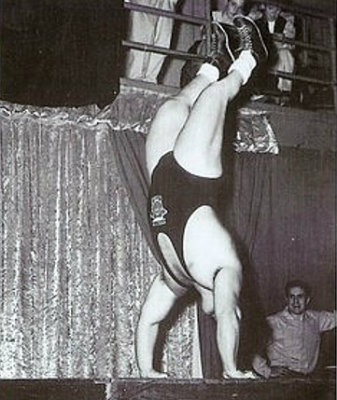
But First: Why Calisthenics?
To put it simply, calisthenics—when stripped down to its most fundamental elements—is the ability to control and master your body in free space. The better you can do that, the easier it is to control external objects in free space as well as defy gravity.
In fact, this is the first thing we learn to do as we’re developing. We don’t build our strength by bench pressing our Legos. We do it by learning to make gravity bend to the will of our bodies by first learning to lift and control our heads, roll around on the ground, rock back and forth, crawl on all fours, and eventually walk upright. These humble beginnings—known as the developmental sequence—set the stage for all the rest of your strength and athleticism, and it starts with defying gravity. When you can make gravity bend to your will, you can make iron do the same.
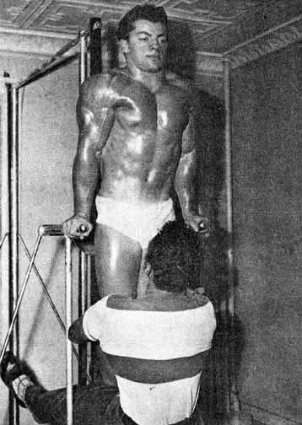
You need only take a look at any of the old school iron legends and you’ll notice one big thing in common: in addition to hoisting preposterous poundages, they always had incredible calisthenics feats to their name.
- “Marvelous” Marvin Eder could reportedly do a mind-bending eight one-arm chin-ups per arm, and John Grimek was said to do six or seven per arm. Moreover, both Eder and proto-powerlifter Pat Casey performed incredibly heavy dips on a regular basis (Eder could do a dip with two 200lb men clinging to his legs), with Casey even occasionally going so far as to do eight-hour dipping sessions (you read that right). Pat Casey was the first man to bench press 600lbs and Marvin Eder was the first man under 200lbs to bench 500. Wonder why.
- British berserker, pro-wrestler, and all-around tough guy Bert Assirati was an iron nut famous for squatting 800lbs before squatting had even become fashionable and curls were still socially acceptable (so long as you didn’t do them in a squat rack). He could easily bust out such next-level calisthenics feats as multiple one-arm chins per arm, stand-to-stand bridges, one-arm handstands, and even the coveted and rarely seen iron cross–all at a not-so-svelte 240lbs.
- The Father of Modern Bodybuilding (and the guy who still appears on Mr. Universe trophies) Eugen Sandow was said to be able to do one-finger chin-ups on any finger of either hand (including his thumb).
- Weightlifter and world record holder Paul “The Wonder of Nature” Anderson routinely performed handstand push-ups and one-legged squats. He also once outran an Olympic gold medalist in sprinting in a twenty-yard dash, which is not bad for anyone, let alone a 350+lb slab of beef.
- Fred Hatfield—more affectionately known as “Dr. Squat”—was the first man to squat 1,000lbs in competition. He started off his athletic career as a gymnast.
So now are you convinced that calisthenics is good for more than just over-produced YouTube videos from behind the former Iron Curtain? Good. Now it’s time to get to work.
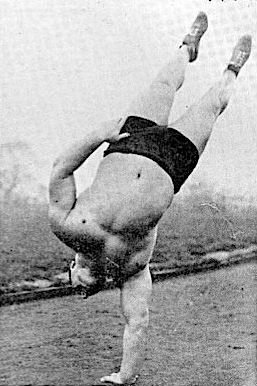
How to Incorporate Calisthenics Into Your Strength Training
Due to the incomparable versatility of bodyweight training, you have multiple choices:
- Drop your iron completely, spend one to three months doing bodyweight training only, and then re-test yourself on your favorite lifts to see how you fare. An extreme approach—and one that can work wonders—but not necessary.
- Save calisthenics for your variety day. A great option that will fit into just about any three-day strength program and allow you to get in some high-quality, low-rep work without feeling rushed.
- Pair a few low-rep sets of calisthenics with an iron drill of your choice.
- A mix of all of the above options.
Just for fun, we’ll go with option four. Why? It will allow you to spread out a number of high-yield calisthenics exercises throughout your program and get the benefits not only of regular low-rep, high tension strength practice, but will do so without overwhelming you. What’s more, you’ll also fill in a lot of gaps in your strength and begin to acquire a variety of skills you’re less likely to get in your regular iron practice. Filling in these cracks will propel you forward in all of your athletic and iron goals.
Let’s say your regular practice is three days a week of the following:
- Double kettlebell clean + press
- Double kettlebell front squat
- Swing
Here’s how we’re going to spice it up, fill in the gaps, and crush weakness even faster using a deadly blend of both iron and your own fair flesh. The following are my recommendations on how to maximize your training with a complementary assortment of classic calisthenics moves.
Main Days
Double kettlebell military press: 3-5×5
+ 2-3 sets of 3-5 handstand push-ups
Double kettlebell front squat: 3-5×5
+ a set of 1-2 hanging leg raises between sets
Weighted pull-ups: 3-5×5 (these weren’t in your original program, so I did you a favor and added them in—you’re welcome).
Single kettlebell swing: 5-10×10
+ 2-3 sets of 2-5 reps of any easy pistol progression before you start swinging
Variety Days
Front lever progression: 5 sets of 5 second holds
L-sit progression: 5 sets of 5 second holds
One-arm one-leg push-up progression: 3×3
Back bridge progression: 3 sets of whatever your current flexibility levels will permit
You might have noticed this is anything but a beginner’s program. This will demand a lot of work from you, and as such will also demand a lot of recovery. I suggest starting your sessions off with some Original Strength resets to get the lifting juices flowing, and to do a cool down of more Original Strength or some of Pavel’s “fast and loose” drills along with Master SFG Jon Engum’s Flexible Steel drills to stretch what you’ve so powerfully tightened.
So what are the benefits of each choice and each pairing?
- Handstand push-ups: These allow you to work on your overhead pressing groove and get in more volume—crucial for overhead pressing success—with less overall fatigue, since simply doing more military presses will serve mostly to trash your legs and abs, which handstand push-ups will not. Moreover, your forearm flexors will get some repose since they’ll no longer be crushing handles during your presses.
- Hanging leg raises: To quote Pavel, “I have never known a single person who regularly practiced hanging leg raises and failed to develop a hard and useful set of abs. Ever.” If that’s not good enough for you (for shame!), hanging leg raises will also help connect your grip, your core, and even your lats into your front squatting efforts. Unless you’re one of those non-squatting chicken leg-types I mentioned earlier in the article, I shouldn’t have to explain why that will be useful for your squats.
- Weighted pull-ups: One of the best back builders around. Your grip and core will sit up and take notice, too.
- Pistols: Pistols are great for building what Pavel refers to as “steering strength,” while also teaching you how to root through your feet and engage your quads, hamstrings, glutes, and abs together at once. My friend Corey Howard of Sioux Falls, South Dakota—a former powerlifter—told me a few years ago he did only pistols for his lower body strength work. When he came back to swings, his heaviest bells suddenly floated with incredible ease.
- Front lever and L-sit progressions: Both of these are fundamental—and indispensable—straight-arm scapular strength moves. Straight arm scapular strength is the final frontier of upper body strength development. Overlooked and under-appreciated by the average strength enthusiast, these are a power tool against weakness in all its forms, and are the greatest way I know of to speed toward ever-increasing strength in all of your favorite feats—including kettlebell and barbell feats. Ignore them to your own detriment. The amount you’ll be doing won’t impress any gymnast (but then again, not much will) but it will set you on the right track, and a little dab will do ya.
- One-arm one-leg push-up: See my blog on this topic so I don’t have to repeat myself here.
- Bridge: We all spend too much time in forward flexion, and most bodyweight feats will only add to that. These will reverse that trend.
So there you have it. A demystified approach to combining iron and bodyweight training to get brutishly strong, defy gravity, and overturn all of your old records, replacing them with newer, more impressive ones. You already have all the tools you need: your iron of choice, your bodyweight, gravity, and time.
Now all you need to add is work. Give it two to three months and let me know how it worked for you. Get after it!
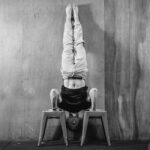
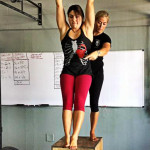
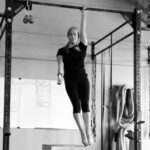
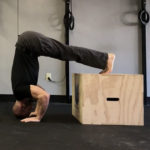
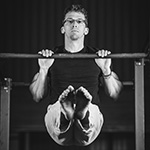


This is an outstanding article! Love old school calisthenics. I must recommend one piece of equipment: a quality pullup bar. This German one I picked up years ago is the perfect tool: https://frstre.com/go/?a=12707-8e4789&s=131840-027509
Hi Aleks, great and useful article. I will attend the SFB next december and the SFG I next June both in Italy.
I did for the last 12 weeks the program of Chief SFB Karen Smith (http://www.strongfirst.com/surprise-yourself-with-strength-on-this-bodyweight-training-plan/) to prepare for the SFB and in the variety days I did swings and get-ups practice.
Now I am able to do a OAOLPU suitable for the cert (an SFG Team Leader evaluated me) so I want to keep it for the cert. The Team Leader encouraged me to start practing again the KB drills (I have some KB skills too, so from january we are going to focus on the Snatch Test for the most) but keeping the BW skills I earned. I think this program is good for the purpose, but how can I incorporate cleans, get-ups and snatches in this? Thanks, you are an inspiration!
And the exercises must be done in superset fashion or, for exemple, 3-5×5 MP and after 2-3×3-5 HSPUs? Thanks!
Aleks, such a good post!
May I ask you for assistance on StrongFirst forum in a discussion inspired by this article: http://www.strongfirst.com/community/threads/hybrid-template-based-on-principles-of-calisthenics-for-iron-domination.7727/
Great article Alex.
Thank you.
S
Thank you!
Great article Alex!
Thank you.
#harderstyle
Aleks, what kind of calisthenics would you recommend on variety days during ROP (option 2 in the article)?
You probably know this already, but ROP features three days a week of c&p plus either snatches or swings.
Thanks!
Hey Miroslav,
I know the ROP well – it’s a great program!
If you’re on the ROP, my recommendations for your variety day would be as follows:
* Pullups
* Pistols (or front squats)
* HLR
* Back Bridge
* one-arm/one-leg pushup progression (low reps only, like 2×5 or 3×3 with a moderate variation)
If you’re more advanced (and can tolerate a higher workload)
* Front lever progression
* Back lever progression
* HLR
* Back bridge
And GTG with pullups and pistols if at all possible. And remember, the point of the variety day is to practice stuff you’re not prioritizing, so don’t try to turn it into a workout, keep it solely as a “strength lesson”. Likewise with GTG.
Hope this helps! Let me know if you have any more questions.
Thank you very much Aleks!
Aleks, do you do all the lifts on each day ?
Respectfully, while acknowledging that the template provided is just an example, it might be preferable to opt for heavy single kettlebell cleans and presses on the main training days rather than doubles, if we’re also to be performing weighted pullups in the same session. In the FAQ section of Return of The Kettlebell (my favorite program, for what it’s worth), the Chief answers the query “may I fit pullups between sets of presses, as in Enter The Kettlebell?” This is answered by reminding us that doubles are so much more taxing than singles that we won’t be able to do the pulls justice–we should focus on actively pulling the KBs back into the rack instead.
It isn’t my intention to argue; after a day or two of mulling it over I decided it was worth mentioning since I’ve learned that when the Chief speaks, I should have listened the first time around.
Wonderful article, Aleks!
Ironically, I actually started blending in a lot of cals 3-4 months back when I lost access to a gym, so I will retroactively qualify myself for a report!
I did a lot of barbell overhead pressing, front squats, and deadlifts before. While I haven’t really found a good bodyweight candidate for DLs, I found that switching to handstand pressing and doing pistols really eased on the spinal decompression, and back bridging has only helped to heal that particular abuse. The balancing and stability elements has also improved my body composition and reduced my uneven aspergers gait when I walk.
After reading your article, I consider myself sold on calisthenics and it will probably be my “go-to” form of training, with a select barbell/kettlebell exercises to complement it.
Thank you!
Thanks for your kind words, Tony!
And those are some serious improvements – way to go! You might also consider crawling and various other resets as found in the Original Strength system as those may also help improve your gait a bit. Look up Original Strength online if you’re not familiar with it.
I’m very happy my article has had such an effect on you. Keep me posted on your progress, and feel free to share the article with your family and friends!
Great article Hammer. Adding these skills to kettlebell training has most certain been helpful on the mats and other martial arts endeavors.
Thank you, Prentiss! And that’s great to hear. Anything that helps a martial artist with your level of skill has to be pretty indispensable to your training!
Very good hybrid routine– how would you structure a workout based on bodyweight only?
Thanks! As for how to structure a bodyweight-only workout, the first thing I’d wanna know is: what would your goal be?
Get better at OAPU;stay strong with a n all around program that included the front lever,pullups,etc.
SF, I have an article on the one-arm/one-leg pushup that will be right up your alley: http://www.strongfirst.com/from-bodyweight-to-heavy-weight-part-1-mining-the-one-armone-leg-pushup-for-a-heavier-military-press/ Add in the other movements to your liking and you will be in business!
Excellent article Aleks, thank you!
Thank you for your kind words, Pavel! Hope to see you soon.
Great post Aleks,
“calisthenics—when stripped down to its most fundamental elements—is the ability to control and master your body in free space”
What could be more important and, to use an abused term, functional?!
Thank you, Carl!
I couldn’t agree more. There is nothing more functional than this.